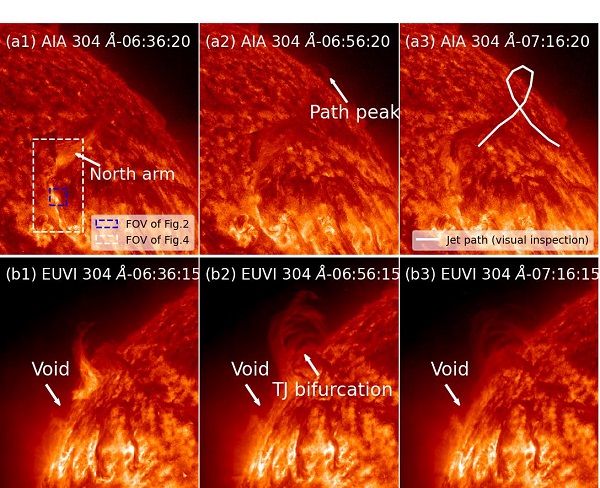The Site Survey and Coronal Observation Group of the Yunnan Observatories of Chinese Academy of Sciences has recently made new observational progress in the diagnosis of the magnetic rope structure of a filament-cavity system. The work carried out by MSc student TAN Song et al. was published in Monthly Notices of the Royal Astronomical Society: Letters (MNRAS Letters).
The fine magnetic structure of filaments is crucial to understanding its formation, stability and eruption. Theoretical models of magnetic flux ropes and sheared arcades are generally available for the magnetic structure of filaments. Among them, the magnetic rope model has been strongly validated in explaining the untwisting and rotation phenomena during filament eruptions.
But how can the magnetic rope structure of filaments, which are composed of cold plasma material suspended in the solar atmosphere and behave as dark absorption structures, be diagnosed on the solar disk? This is still an open question. In recent years, some researchers have diagnosed the magnetic field information of the filament with the help of jets injected into the filament to illuminate their magnetic structure.
Using stereoscopic observations from the Solar Dynamics Observatory and Solar Terrestrial Relations Observatory, Tan Song et al. have studied the production of two-sided-loop jets and discovered for the first time the ejection of jet material into the magnetic structure of the filament-cavity system. The motion of the jet exhibited a high degree of twist, from which they obtained the twist number of that part of the filament. Subsequently, the motion of the jet shows a clear bifurcation, with most of the jet entering the coronal cavity structure at the periphery of the filament.
The coronal cavity structure is often observed at the periphery of the large quiescent filaments, which are observed axially along the filaments at the edge of the disk. The trajectory of the jet allows us to directly "see" the magnetic field of the coronal cavity. The phenomena studied by Tan Song et al. provide strong evidence for the filament-cavity magnetic rope theory: the filament and the coronal cavity are different parts of the same magnetic structure.
The jet generated near the foot of the filament enters the magnetic structure of the coronal cavity, suggesting that the magnetic structures of the filament and coronal cavity are closely linked near the active area, and gradually separate as they move away from the active area. They also calculated the decay index of the magnetic field at 50 Mm above the filament. The lower decay index provides a reasonable explanation for the large twist number of the filament, which is subject to perturbation without eruption.
This study continues the tradition of the Site Survey and Coronal Observation Group in the study of two-sided-loop jets and explores new forms of interaction between jets and filament. On this basis, it also provides a new perspective for further understanding of the structure of the magnetic rope.
The research is supported by the National Natural Science Foundation of China, the Yunnan Provincial Basic Research Program, and the National Key Research and Development Program of China.
Contact:
TAN Song
Yunnan Observatories,CAS
Email: tansong@ynao.ac.cn

Fig.1 This diagram shows the process of two-sided-loop jet generation, from which the distinctive loop-like feature and subsequent bi-directional sharp-angled plasma flow can be seen.

Fig. 2 This diagram shows the highly twisted pattern of the two-sided-loop jet within the filament, which is illustrated with cyan scatter.

Fig. 3 This figure is a stereoscopic view of SDO and STEREO, showing the trajectory of the jet as it deviates from the filament spine and then moves through the coronal cavity.